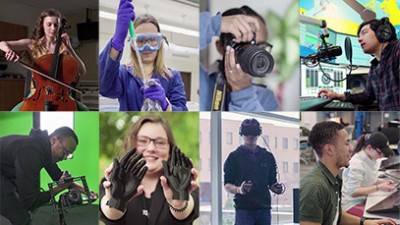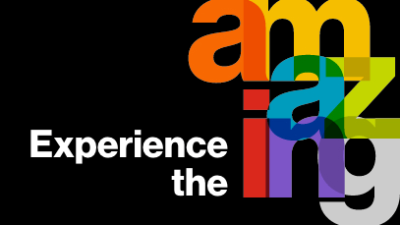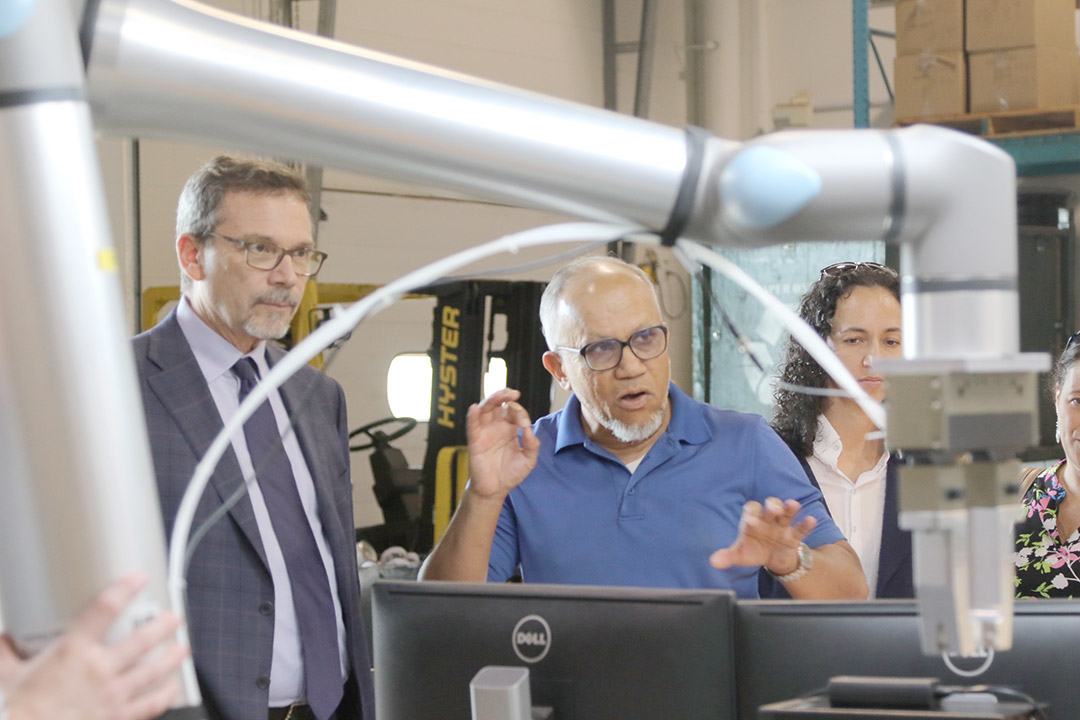RIT aids in global climate solution initiatives
Multidisciplinary group combines expertise to make Governors Island a hub of environmental resource innovation
Corey Nash/RIT
Stephen Hammer, left, and Andel Koester, right, director of community initiatives for the New York Climate Exchange, visit RIT’s Golisano Institute of Sustainability lab as Abu Islam, an associate research professor explains a robotic arm used for textile recycling for a project by the REMADE Institute.
The innovative talent, technology, and creativity at Rochester Institute of Technology are valuable resources that can help visionaries build a new climate-focused center on Governors Island in New York City.
That’s what Stephen Hammer, CEO of the New York Climate Exchange, experienced firsthand this week during a two-day visit to RIT, which included a discussion Tuesday in Ingle Auditorium.
“One thing that’s so valuable to me is having visits like this with our partners to learn more about where your particular research expertise, areas of student interests, and your facilities may plug in,” he said. “When we saw the SHED yesterday, we were so impressed by how you designed and use the space. There are so many ideas we can draw on for our ideas.”
The Exchange plans to build a 400,000-square-foot campus on Governors Island, in the West River, next to the Statue of Liberty. The groundbreaking is expected to take place next year, with completion in 2028. One of the new facilities will be a state-of-the-art building with a serpentine roof that resembles a roller coaster with a solar canopy.
But it’s not an initiative focused solely on New York City.
“We’re going to build a new climate campus that will have dedicated educational, research, and tech incubation. We want to facilitate conversations about how we move the needle on climate change, both locally, at a state level, and globally,” Hammer said.
Governor’s Island Trust and the New York City Mayor’s Office
Aerial rendering of the Exchange, scheduled for completion in 2028, showing the iconic forms designed to evoke the dramatic landscapes and hills of Governors Island.
The 175-acre Island transitioned from a military installation in 2003 to land controlled by the City of New York.
The Island, 70 feet above sea level, is particularly susceptible to climate change and was “whacked pretty hard” by Hurricane Sandy in 2012, Hammer said, so studying the area’s ecosystem will be important.
“We have to figure out how to navigate our rainwater and wastewater independently of city systems, and create an open, inviting environment so when people walk off the ferry boat to the island, when you walk off Yankee Pier four years from now, you’ll walk into the heart of campus,” Hammer said. “You’ll go through our landscaping, through our activities on the first floor, provide educational opportunities, and provide exposure to what researchers and engineers are doing.”
RIT was one of the first of a dozen universities to join Stony Brook University in creating the Exchange, which was formally announced in 2023.
The Exchange has 48 educational and private company partners, including IBM, consulting groups, labor unions, a chamber of commerce, workforce development groups, environmental justice groups, even the Boys and Girls Club.
The affiliations include nine engineering schools; eight schools of public health; six schools of public policy; five schools of communication; and three schools each of marine science and atmospheric science.
“The bench of talent that we could potentially attract for our projects is quite extraordinary,” Hammer said.
Hammer, formerly senior policy advisor on climate solutions for the World Bank and a leading expert on global climate policy matters, said he’s had discussions about climate issues from Singapore to Finland, Africa to Latin America. A common concern is what to do with discarded automotive batteries that need disassembly. He said a current project at RIT’s Golisano Institute for Sustainability could help.
”They have this very cool robot that’s learning how to take apart automotive batteries,” Hammer said. “You have systems designed by folks, like the one being tried here, that can accelerate the solution. It was fantastic to see people are already starting to think about that.”
He said conversations with RIT faculty will help them consider how to move forward, and can be a tremendous resource for industry, whether for research or policy making.
“We want to talk to scientists, researchers, tech entrepreneurs and be inspired,” Hammer said. “They are providing the solutions that will get us to tomorrow. There is so much going on in our partner institutions that we need to be taking an inventory. What are you doing? How does that relate? The intention is not to duplicate what you are already doing, but to build on that.”
Other than GIS, RIT could contribute expertise from the New York State Center of Excellence in Advanced and Sustainable Manufacturing, the New York State Pollution Prevention Institute and the REMADE Institute.
RIT’s imaging science faculty and students could use drones to map tree cover density, or lack thereof, to help monitor heat in certain locations. Even game design and development faculty can play a role.
“I know several people in the client world who are trying to think about different ways to engage youth in a useful way,” Hammer said. “So we can talk to the faculty here who specialize in that. That’s an area of expertise we haven’t run into as much, so that may be an advantage RIT may bring to our projects.”
The collaboration has already started. RIT student Ericka Chen participated in the inaugural summer internship program on Governors Island this summer as a finance and accounting intern.
Hammer said educating youth about the environment, including K-12 and college students, is a component of their plans. Summer camps, teacher training, and curriculum development are all possible, as are art and culture programs linked to climate elements.
He said the Exchange welcomes thoughts and ideas at info@NYClimateExchange.org.
“This is the beginning of an extended conversation building what we really hope is a long and productive relationship,” Hammer said. “We are bringing things to you, and we are drawing on all you are bringing to the table.”
RIT President David Munson said the affiliation with the Exchange is mutually beneficial and easily accomplished, as RIT already extends its efforts far beyond the classroom to include regional, national, and global collaborations to better the world.
“With research and program offerings in areas such as the circular economy, package design, clean technology and policy, business, and environmental management, RIT is well-positioned to be a transformative force in the creation of a sustainable economy,” he said.
“There is no doubt that there is exciting, innovative and meaningful work already underway at the Exchange,” Munson said. “It’s exciting, and it’s just getting started.”














